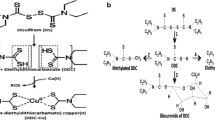Summary
The antitumor drug pyrazine-2-diazohydroxide exhibits cytotoxicity to A204 tumor cells in vitro under acid conditions. The IC50 with a 1 hr drug exposure at pH of 7.4 was 61 μg/ml and at pH of 6.0 it was 31 μg/ml. It is suggested that the increased cytotoxicity is due to the acid catalyzed formation of a reactive pyrizinyldiazonium ion from pyrazine-2-diazohydroxide. Pyrazine-2-diazohydroxide is also more cytotoxic to A204 cells under hypoxic conditions in the presence of glucose with an IC50 at pH 7.4 of 22 μg/ml. The increased cytotoxicity of pyrazine-2-diazohydroxide under acid and hypoxic conditions may favor selective toxicity to solid tumors in vivo. Coincubation with rat hepatic microsomes increased the cytotoxicity of pyrazine-2-diazohydroxide to A204 cells. The effect did not require NADPH and was not due to formation of metabolites. There was an increased rate of degradation of pyrazine-2-diazohydroxide in the presence of microsomes, presumably with formation of the pyrizinyldiazonium ion. The final degradation product 2-hydroxypyrazine was not cytotoxic to A204 cells. The effect of microsomes on pyrazine-2-diazohydroxide cytotoxicity is probably of little in vivo significance.
Similar content being viewed by others
References
Plowman J, Haugwitz RD, Narayanan VL, Baker DC, Hand ES, Rampal JB, Safavy A: Preclinical antitumor activity of pyrazine diazohydroxide NSC 361456. (Abstr) Proc Amer Assoc Cancer Res 27:275, 1986
Wilke TJ, Kooistra KL, Moore DJ, Powis G: Gas Chromatographic assay for the new antitumor agent pyrazine-2-diazohydroxide (diazohydroxide) and its stability in buffer, blood and plasma. J Chromatogr 383:77–83, 1986
Bunton CA, Minch MJ, Wolfe BB: Decomposition of pyridine-2 and 4-diazotots. J Amer Chem Soc 96:3267–3275, 1974
Moore DJ, Brodfüehrer JI, Powis G: Metabolism and disposition of pyrazine-2-diazohydroxide in mouse and beagle dog. Cancer Pharmacol Ther, in press, 1988
Metzler CM, Elfring G, McEwen EJ: A package of computer programs for pharmacokinetic modeling. Biometrics 30:562–567, 1974
Snedecor GW, Cochran WG: The comparison of two samples. In: Statistical Methods. Iowa State University Press, Ames, IA, 1967, pp 91–119
Ernster L, Siekevitz P, Palade PE: Enzyme-structure relationships of the endoplasmic reticulum of rat liver. J Cell Biol 15:541–562, 1962
Bradford M: A rapid and sensitive method for the quantitation of microgram quantities of protein utilizing the principle of protein-dye binding. Anal Biochem 72:248–254, 1976
Powis G, Hodnett EM, Santone KS, Lee-See K, Melder DC: Role of metabolism and oxidation-reduction cycling in the cytotoxicity of antitumor quinoneimines and quinonediimines. Cancer Res 47:2363–2370, 1987
Weinkam P, Shiba D: Procarbazine. In: B Chabner (ed) Pharmacological Principles of Cancer Treatment. Saunders, Philadelphia, PA, 1982, pp 340–362
Kennedy KA, McGurl JD, Leondaridis L, Alabaster G: pH Dependence of mitomycin C-induced crosslinking activity in EMT6 tumor cells. Cancer Res 45:3541–3547, 1985
Guillino PM: In vivoutilization of oxygen and glucose by neoplastic tissue. Adv Exp Med Biol 75:521–536, 1975
Guillino PM, Grantham FH, Smith SH, Haggerty AC: Modifications of the acid-base status of the internal milieu of tumors. J Natl Cancer Inst 34:857–869, 1965
Vaupel PW, Frinak S, Bicher HI: Heterogenous oxygen partial pressure and pH distribution in C3H mouse mammary adenocarcinoma. Cancer Res 41:2008–2013, 1981
Robin ED, Murphy BJ, Theodore J: Coordinate regulation of glycolysis by hypoxia in mammalian cells. J Cell Physiol118:287–290, 1984
Busa WB, Nuccitelli R: Metabolic regulation via intracellular pH. Amer J Physiol 246:R409-R438, 1984
Moulder JE, Rockwell S: Hypoxic fractions of solid tumors: experimental techniques, methods of analysis, and a survey of existing data. Int J Radial Oncol Biol Phys 10:695–712, 1984
Dische S: Chemical sensitizers for hypoxic cells: a decade of experience in clinical radiotherapy. Radiother Oncol 3:97–115, 1985
Sartorelli AC: Role of hypoxic cells in the therapeutic response of solid tumors. (Abstr) Proc Amer Assoc Cancer Res 28:461, 1987
Author information
Authors and Affiliations
Rights and permissions
About this article
Cite this article
Brodfüehrer, J.I., Moore, D.J., Melder, D.C. et al. In vitro cytotoxicity of pyrazine-2-diazohydroxide: specificity for hypoxic cells and effects of microsomal coincubation. Invest New Drugs 6, 3–9 (1988). https://doi.org/10.1007/BF00170773
Issue Date:
DOI: https://doi.org/10.1007/BF00170773




